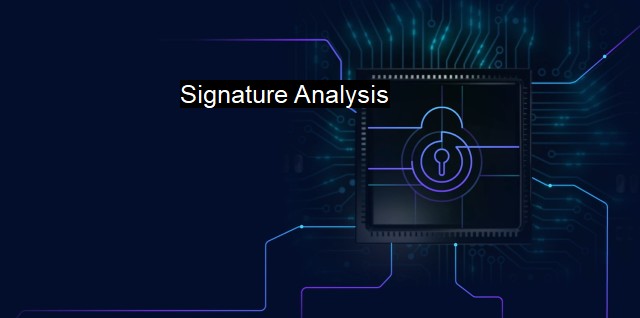What are Signature Analysis?
The Importance of Signature Analysis in Modern Cybersecurity: A Technology for Identifying and Blocking Malware.
Signature Analysis, prevalent pertains to a method whereby software is employed to compare the set of distinct traits within a given code or program with a database comprising identified malware. This procedure, if correctly executed, aids in the detection of possible threats, thereby fortifying the system's security. signature analysis is predicated on familiarity. It is impotent against fresh threats, or 'zero-day' threats, that haven't yet been catalogued in the database.But let's trace back a little and further define the basics. a signature is an extractable element or a distinctive trait recognized within the code or algorithm of viruses, worms, trojans, and other kinds of malicious software or malware. The signature of any malware is essentially the unique DNA or fingerprint, which antivirus software leverages to impartially identify, hunt, and obliterate that malware.
Signature Analysis becomes a paramount subject to discuss in cybersecurity and antivirus circles due to the complexities involved in identifying and mitigating potential threats to systems. As attackers become progressively sophisticated, they devise complex code or malwares that can easily bypass signature-based detection. Intriguingly, by simply tweaking the code incrementally, they make detection impossibly difficult.
Antivirus software executes an analysis and seeks matches between the prospective signature from these traits and the vast malware database it possesses. On the detection of a match, it points to the existence of a known form of malware within the system, which can then be eliminated.
Signature analysis scores high on the accuracy front when it comes to identifying known threats. The high matching precision is due to the uniqueness of malware signatures. Once a malware's signature is identified and catalogued, the antivirus software can spot that malware with utmost accuracy.
Signature analysis exhibits a severe weakness in its cumbersome inability to recognize potential threats that are entirely new or even skillfully obfuscated. These new threats that the software is unacquainted with, referred to as 'zero-day' threats, are markedly devastating as they appear and set afoot damage before a signature for them can be constructed and added to the database. Besides, attackers evolve their creations continually to let them escape the eyes of signature-based detection, making the system vulnerable.
Greasing the wheel for them, there are toolkit readily available that aid attackers in mast-crafting their algorithms to discreetly conceal or distort the malware's signature. The malware with successfully obfuscated signature or code manages to hide in plain sight, making signature analysis in cybersecurity ineffective.
The advancement in technology and cybersecurity has propounded other forms of threat detection that operate on heuristic or behaviour-based analysis. With time, mere signature analysis is being gradually replaced with artificial intelligence and machine learning-based threat detection methods. Antivirus solutions like sandboxing, intrusion prevention systems, or advanced persistent threat detection or mitigation systems are beginning to be in wide use, confronting the shortcomings of signature-based analysis, they employ advanced algorithms to identify unknown threats and predict possible malware attacks.
Signature Analysis is a traditional yet crucial method in cybersecurity involving the comparison of program traits with a database of catalogued malware. it's found wanting when it comes to addressing unknown or morphed threats. It's thankfully ushered in the need for, and heralded, the development of stalwart solutions endowed with predictive capabilities.

Signature Analysis FAQs
What is signature analysis in cybersecurity?
Signature analysis in cybersecurity refers to the process of identifying and analyzing the unique patterns or signatures of viruses or malware in order to detect and prevent their spread.How does signature analysis work in antivirus software?
Antivirus software uses signature analysis to compare the digital signature of a suspicious file or program against a database of known malware signatures. If the signature of the file matches a known malware signature, the antivirus program will flag it as a threat and take appropriate action.What are the limitations of signature analysis in cybersecurity?
One of the main limitations of signature analysis is that it can only detect known malware signatures. If a new or unknown type of malware is encountered that does not match any known signatures, signature analysis will not be effective in detecting and preventing its spread.How can signature analysis be complemented in cybersecurity?
To complement signature analysis, cybersecurity experts also use behavior analysis and machine learning algorithms that can identify patterns of malicious behavior beyond simple signature patterns. This approach helps to detect new or previously unknown types of malware that do not have a known signature.| | A | | | B | | | C | | | D | | | E | | | F | | | G | | | H | | | I | | | J | | | K | | | L | | | M | |
| | N | | | O | | | P | | | Q | | | R | | | S | | | T | | | U | | | V | | | W | | | X | | | Y | | | Z | |
| | 1 | | | 2 | | | 3 | | | 4 | | | 7 | | | 8 | | |||||||